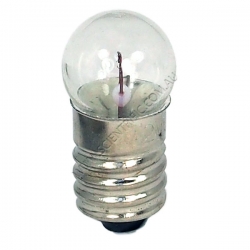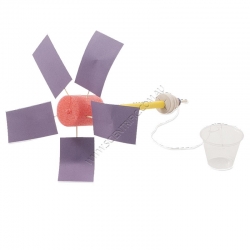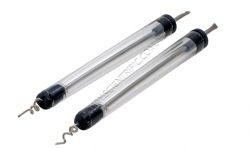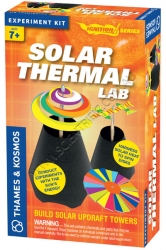114 low relevance results shown for 'Electric'. Prev |1|2|3|4|5 | Next | View 100 per page
Showing low relevance matches only. Return to normal search results
Electrical Circuits - Electrical energy can be transferred and transformed in electrical circuits and can be generated from a range of sources ACSSU219 Year 6 Physical Sciences
Alternative Energies - Energy from a variety of sources can be used to generate electricity ACSCH030 Year 11 Chemical fundamentals
Properties and structure of materials - Ions are atoms or groups of atoms that are electrically charged due to an imbalance in the number of electrons and protons; ions are represented by formulae which include the number of constituent atoms and the charge of the ion (for example, O2–, SO42–) ACSCH032 Year 11 Chemical fundamentals
Properties and structure of materials - The characteristic properties of metals (for example, malleability, thermal conductivity, electrical conductivity) are explained by modelling metallic bonding as a regular arrangement of positive ions (cations) made stable by electrostatic forces of attra ACSCH108 Year 12 Equilibrium acids and redox reactions
Oxidation and reduction - Galvanic cells, including fuel cells, generate an electrical potential difference from a spontaneous redox reaction; they can be represented as cell diagrams including anode and cathode halfequations ACSPH016 Year 11 Thermal nuclear and electrical physics
Heating processes - Heat transfer occurs between and within systems by conduction, convection and/or radiation ACSPH020 Year 11 Thermal nuclear and electrical physics
Heating processes - Provided a substance does not change state, its temperature change is proportional to the amount of energy added to or removed from the substance; the constant of proportionality describes the heat capacity of the substance ACSPH022 Year 11 Thermal nuclear and electrical physics
Heating processes - Two systems in contact transfer energy between particles so that eventually the systems reach the same temperature; that is, they are in thermal equilibrium ACSPH028 Year 11 Thermal nuclear and electrical physics
Ionising radiation and nuclear reactions - Some nuclides are unstable and spontaneously decay, emitting alpha, beta and/or gamma radiation over time until they become stable nuclides ACSPH029 Year 11 Thermal nuclear and electrical physics
Ionising radiation and nuclear reactions - Each species of radionuclide has a specific halflife ACSPH030 Year 11 Thermal nuclear and electrical physics
Ionising radiation and nuclear reactions - Alpha, beta and gamma radiation have sufficient energy to ionise atoms ACSPH039 Year 11 Thermal nuclear and electrical physics
Electrical circuits - Energy is conserved in the energy transfers and transformations that occur in an electrical circuit ACSPH040 Year 11 Thermal nuclear and electrical physics
Electrical circuits - The energy available to charges moving in an electrical circuit is measured using electric potential difference, which is defined as the change in potential energy per unit charge between two defined points in the circuit ACSPH041 Year 11 Thermal nuclear and electrical physics
Electrical circuits - Energy is required to separate positive and negative charge carriers; charge separation produces an electrical potential difference that can be used to drive current in circuits ACSPH042 Year 11 Thermal nuclear and electrical physics
Electrical circuits - Power is the rate at which energy is transformed by a circuit component; power enables quantitative analysis of energy transformations in the circuit ACSPH043 Year 11 Thermal nuclear and electrical physics
Electrical circuits - Resistance for ohmic and nonohmic components is defined as the ratio of potential difference across the component to the current in the component ACSPH044 Year 11 Thermal nuclear and electrical physics
Electrical circuits - Circuit analysis and design involve calculation of the potential difference across, the current in, and the power supplied to, components in series, parallel and series/parallel circuits ACSPH137 Year 12 Revolutions in modern physics
Quantum theory - A wide range of phenomena, including black body radiation and the photoelectric effect, are explained using the concept of light quanta ACSPH108 Year 12 Gravity and electromagnetism
Electromagnetism - Magnets, magnetic materials, moving charges and currentcarrying wires experience a force in a magnetic field; this force is utilised in DC electric motors ACSPH021 Year 11 Thermal nuclear and electrical physics
Heating processes - Change of state involves internal energy changes to form or break bonds between atoms or molecules; latent heat is the energy required to be added to or removed from a system to change the state of the system ACSCH031 Year 11 Chemical fundamentals
Properties and structure of materials - The properties of ionic compounds (for example, high melting point, brittleness, ability to conduct electricity when liquid or in solution) are explained by modelling ionic bonding as ions arranged in a crystalline lattice structure with forces of attract ACSCH027 Year 11 Chemical fundamentals
Properties and structure of atoms - The type of bonding within substances explains their physical properties, including melting and boiling point, conductivity of both electricity and heat, strength and hardness ACSPH103 Year 12 Gravity and electromagnetism
Electromagnetism - A positively charged body placed in an electric field will experience a force in the direction of the field; the strength of the electric field is defined as the force per unit charge ACSPH104 Year 12 Gravity and electromagnetism
Electromagnetism - Point charges and charged objects produce an electric field in the space that surrounds them; field theory attributes the electrostatic force on a point charge or charged body to the presence of an electric field ACSPH105 Year 12 Gravity and electromagnetism
Electromagnetism - When a charged body moves or is moved from one point to another in an electric field and its potential energy changes, work is done on or by the field









114 low relevance results shown for 'Electric'. Prev |1|2|3|4|5 | Next | View 100 per page
Showing low relevance matches only. Return to normal search results
Curriculum resources related to 'Electric'
ACSSU097 Year 6 Physical SciencesElectrical Circuits - Electrical energy can be transferred and transformed in electrical circuits and can be generated from a range of sources ACSSU219 Year 6 Physical Sciences
Alternative Energies - Energy from a variety of sources can be used to generate electricity ACSCH030 Year 11 Chemical fundamentals
Properties and structure of materials - Ions are atoms or groups of atoms that are electrically charged due to an imbalance in the number of electrons and protons; ions are represented by formulae which include the number of constituent atoms and the charge of the ion (for example, O2–, SO42–) ACSCH032 Year 11 Chemical fundamentals
Properties and structure of materials - The characteristic properties of metals (for example, malleability, thermal conductivity, electrical conductivity) are explained by modelling metallic bonding as a regular arrangement of positive ions (cations) made stable by electrostatic forces of attra ACSCH108 Year 12 Equilibrium acids and redox reactions
Oxidation and reduction - Galvanic cells, including fuel cells, generate an electrical potential difference from a spontaneous redox reaction; they can be represented as cell diagrams including anode and cathode halfequations ACSPH016 Year 11 Thermal nuclear and electrical physics
Heating processes - Heat transfer occurs between and within systems by conduction, convection and/or radiation ACSPH020 Year 11 Thermal nuclear and electrical physics
Heating processes - Provided a substance does not change state, its temperature change is proportional to the amount of energy added to or removed from the substance; the constant of proportionality describes the heat capacity of the substance ACSPH022 Year 11 Thermal nuclear and electrical physics
Heating processes - Two systems in contact transfer energy between particles so that eventually the systems reach the same temperature; that is, they are in thermal equilibrium ACSPH028 Year 11 Thermal nuclear and electrical physics
Ionising radiation and nuclear reactions - Some nuclides are unstable and spontaneously decay, emitting alpha, beta and/or gamma radiation over time until they become stable nuclides ACSPH029 Year 11 Thermal nuclear and electrical physics
Ionising radiation and nuclear reactions - Each species of radionuclide has a specific halflife ACSPH030 Year 11 Thermal nuclear and electrical physics
Ionising radiation and nuclear reactions - Alpha, beta and gamma radiation have sufficient energy to ionise atoms ACSPH039 Year 11 Thermal nuclear and electrical physics
Electrical circuits - Energy is conserved in the energy transfers and transformations that occur in an electrical circuit ACSPH040 Year 11 Thermal nuclear and electrical physics
Electrical circuits - The energy available to charges moving in an electrical circuit is measured using electric potential difference, which is defined as the change in potential energy per unit charge between two defined points in the circuit ACSPH041 Year 11 Thermal nuclear and electrical physics
Electrical circuits - Energy is required to separate positive and negative charge carriers; charge separation produces an electrical potential difference that can be used to drive current in circuits ACSPH042 Year 11 Thermal nuclear and electrical physics
Electrical circuits - Power is the rate at which energy is transformed by a circuit component; power enables quantitative analysis of energy transformations in the circuit ACSPH043 Year 11 Thermal nuclear and electrical physics
Electrical circuits - Resistance for ohmic and nonohmic components is defined as the ratio of potential difference across the component to the current in the component ACSPH044 Year 11 Thermal nuclear and electrical physics
Electrical circuits - Circuit analysis and design involve calculation of the potential difference across, the current in, and the power supplied to, components in series, parallel and series/parallel circuits ACSPH137 Year 12 Revolutions in modern physics
Quantum theory - A wide range of phenomena, including black body radiation and the photoelectric effect, are explained using the concept of light quanta ACSPH108 Year 12 Gravity and electromagnetism
Electromagnetism - Magnets, magnetic materials, moving charges and currentcarrying wires experience a force in a magnetic field; this force is utilised in DC electric motors ACSPH021 Year 11 Thermal nuclear and electrical physics
Heating processes - Change of state involves internal energy changes to form or break bonds between atoms or molecules; latent heat is the energy required to be added to or removed from a system to change the state of the system ACSCH031 Year 11 Chemical fundamentals
Properties and structure of materials - The properties of ionic compounds (for example, high melting point, brittleness, ability to conduct electricity when liquid or in solution) are explained by modelling ionic bonding as ions arranged in a crystalline lattice structure with forces of attract ACSCH027 Year 11 Chemical fundamentals
Properties and structure of atoms - The type of bonding within substances explains their physical properties, including melting and boiling point, conductivity of both electricity and heat, strength and hardness ACSPH103 Year 12 Gravity and electromagnetism
Electromagnetism - A positively charged body placed in an electric field will experience a force in the direction of the field; the strength of the electric field is defined as the force per unit charge ACSPH104 Year 12 Gravity and electromagnetism
Electromagnetism - Point charges and charged objects produce an electric field in the space that surrounds them; field theory attributes the electrostatic force on a point charge or charged body to the presence of an electric field ACSPH105 Year 12 Gravity and electromagnetism
Electromagnetism - When a charged body moves or is moved from one point to another in an electric field and its potential energy changes, work is done on or by the field
Products related to 'Electric'

IEC Lamp Torch Bulb MES 2.5V 300mA
IEC LAMP GLOBE MES 2.5V 300mA PACK 10
A pack of 10 general purpose 2.5V x 300mA MES (Miniature Edison Screw) light bulbs for electrical experiments.
Order code: PA2040-020

IEC Lamp Torch Bulb MES 3.5V 300mA
IEC LAMP GLOBE MES 3.5V 300mA PACK 10
A pack of 10 general purpose 3.5V X 300mA MES (Miniature Edison Screw) light bulbs for electrical experiments.
Order code: PA2040-030

IEC Lamp Torch Bulb MES 3.8V 300mA
IEC LAMP GLOBE MES 3.8V 300mA PACK 10
A pack of 10 general purpose 3.8V X 300mA MES (Miniature Edison Screw) light bulbs for electrical experiments.
Order code: PA2040-032

IEC Lamp Torch Bulb MES 4.5V 300mA
IEC LAMP GLOBE MES 4.5V 300mA PACK 10
A pack of 10 general purpose 4.5V x 300mA MES (Miniature Edison Screw) light bulbs for electrical experiments.
Order code: PA2040-035

IEC Lamp Torch Bulb MES 6.5V 300mA
IEC LAMP GLOBE MES 6.5V 300mA PACK 10
A pack of 10 general purpose 6.5V x 300mA MES (Miniature Edison Screw) light bulbs for electrical experiments.
Order code: PA2040-040
IEC Ripple Tank Illuminator only Hangs from Frame
IEC RIPPLE TANK ILLUMINATOR ONLY
An illuminator only for the SW3430-001 IEC Ripple Tank. The illuminator hangs by its electrical cable from a stainless steel support frame (PA3430-015 not included). The housing with 12V 25W QI reflector lamp throws light down through the ...
Order code: PA3430-013
IEC Dissectible Transformer Small Low V U Core Only
IEC SMALL DISSECTIBLE TRANSFORMER U CORE ONLY
A small, low voltage, dissectible transformer 'U' core only with plastic shroud. It is packaged with 3 x coils and magnets and iron bars for basic 12V AC transformer work.
Spare part for the EM1973-001 IEC Hodson Induction ...
Order code: PA4089-010
IEC Dissectible Transformer Small Low V I Core Only
IEC SMALL DISSECTIBLE TRANSFORMER I CORE ONLY
A small, low voltage, dissectible transformer 'I' core only with plastic shroud. It is packaged with 3 x coils and magnets and iron bars for basic 12V AC transformer work.
Spare part for the EM1973-001 IEC Hodson Induction ...
Order code: PA4089-011

MacGyver Windmill Class Pack
Replaced by SC1160-10 and SC1160-20
Use common household materials to build a windmill. Explore the engineering behind blade design and windmill construction, participate in a Wind Turbine Blade Design Challenge and explore KidWind’s WindWise curriculum.
Includes materials for 15 Windmills, suitable for use with...
Order code: RL-MACGX

Mini Windmill Class Pack
Replaced by SC1165-10 and SC1165-20
Build a Mini Windmill to learn about how the wind can do work! Students use basic materials like paper plates and straws to construct a device that spins in the wind in order to lift weight. The Mini Windmill kit is an excellent way to help young students build a foundation to un...
Order code: RL-MINIWX

Hofmann Voltameter Electrodes Platinum Pair
A pair of platinum wire electrodes made in Australia with stainless steel electrical connections. Not cheap but made to last and address quality control problems associated with imported electrodes.
You will need to fit rubber stoppers to suit the diameter of your voltammeter....
Order code: SC7091
Hofmann Voltameter Electrodes Carbon Pair
A pair of carbon electrodes made in Australia with stainless steel electrical connections. Not cheap but made to last and address quality control problems associated with imported electrodes.
Order code: SC7092
Conductivity Rods in Cardboard Tube
A set of six, 300x3mm metal rods, to show the physical properties of: aluminium, brass, copper, iron, lead and stainless steel. Also use for conductivity experiments.
Do not place the rods in a bunsen or similar flame.
A common use for these rods is to compare the he...
Order code: SC7239

Solar Thermal Lab
SOLAR THERMAL LAB
Solar thermal energy refers to the technology of collecting solar energy in the form of heat and making it useful, for example, by converting it into electricity or heating homes. Huge solar thermal towers are being installed in sunny places around the w...
Order code: 657123
114 low relevance results shown for 'Electric'. Prev |1|2|3|4|5 | Next | View 100 per page



 ,
,